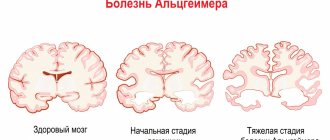Multiple sclerosis
– a disease of the nervous system that can occur both in young and middle age (15–40 years). Multiple sclerosis tends to affect various parts of the nervous system, which leads to the appearance of a variety of neurological symptoms. Most often, women aged 20 to 40 years are affected by the disease. Multiple sclerosis affects the spinal cord and brain and leads to impaired coordination, vision and sensitivity in the patient.
It is important to note that multiple sclerosis is an autoimmune disease.
, in which the immune system, instead of fighting foreign cells, begins to fight its own healthy cells.
During the course of the disease, the patient develops areas of sclerotic tissue or scars in the area of the brain and spinal cord, as a result of which the energy impulses passing through these areas are suppressed or distorted, which leads to disruption of the functioning of the entire body.
Types of Multiple Sclerosis
Multiple sclerosis comes in different types; depending on this, the treatment method is determined and the complexity of the disease is predicted. Types of multiple sclerosis include:
Primary progressive:
sclerosis, in which there is a constant deterioration in the patient’s condition. The attacks are mild or not noticeable at all. At this stage of sclerosis, problems with walking, vision, speech, bowel movements and urination occur.
Relapsing-remitting:
generally begins to manifest itself at the age of 15-20 and is characterized by periodic attacks. The symptoms of the disease are constantly changing and can manifest themselves in the form of pain in the eyes, dizziness, depression, decreased thinking, and deterioration of coordination.
Secondary progressive:
This type of sclerosis develops on the basis of relapsing-remitting sclerosis, which lasted a long period of time (several years). This type is characterized by a stable onset, without any special relapses or remissions. Symptoms include a significant deterioration in coordination of movements, increased depression, problems with thinking, high fatigue, and disturbances in the functioning of the intestines and bladder.
Progressive-relapsing:
a mildly widespread type of sclerosis with periodic attacks and persistence of symptoms between relapses. Symptoms are similar to secondary progressive sclerosis.
Sign up for treatment for multiple sclerosis
Make an appointment
How does RRMS develop?
The level of disease activity and degree of progression should be determined periodically by neurological examination and MRI. This knowledge can help the neurologist prescribe the necessary treatment and predict the expected results. For example:
- In the case of active and/or worsening RRMS, hospitalization with treatment aimed at extinguishing the latest exacerbations may well be necessary. This usually involves intravenous followed by oral methylprednisolone therapy.
- If there are no obvious deteriorations and new symptoms due to the treatment received, but new foci of inflammation are identified on the MRI, then it may be necessary to switch to another type of treatment, which allows you to consolidate the achieved results for a longer period.
- In the case when the course of RRMS is not active, without deterioration and without the emergence of new inflammation on MRI, we can say with confidence that the chosen type of treatment is effective.
Causes of multiple sclerosis
Modern medicine cannot give an exact answer to this question. The generally accepted opinion of doctors is the presence of unfavorable external and internal factors affecting the patient. Such unfavorable factors include:
- Poor nutrition
- Frequent viral or bacterial infections
- Spinal and brain injuries
- Stressful situations
- Genetic predisposition
- Radiation and toxic substances
- Geoeconomic place of growing up and living
- Vitamin D deficiency
- Autoimmune reactions in the body
Common symptoms and signs of multiple sclerosis
It is immediately worth noting that the course of the disease for each patient is purely individual. In one person, multiple sclerosis can manifest itself very violently, while in another it can be completely unnoticeable. But general symptoms of sclerosis include:
Diagnosis of RRMS
The criterion for diagnosing a relapsing-remitting course of MS is evidence of the presence of affected areas of myelin in at least two areas of the central nervous system (spread in areas) that occurred at different times (spread over time). And of course, other diseases that can lead to the same symptoms must be excluded.
When distribution in areas and distribution over time is proven (the fastest and most accurate method is MRI), as well as a neurological examination, a diagnosis can be made quickly.
In cases where lesions in two different sites are not confirmed or cases are not confirmed to have occurred at different times, a clinically isolated syndrome may be diagnosed. In this case, it may take time (several months, years) to establish a final diagnosis.
Treatment of multiple sclerosis
It is important to know that a 100% cure for sclerosis does not currently exist. Modern medicine can only reduce or slow down the harmful effects of the disease.
The treatment approach consists of three stages:
The main goals of treatment include:
Exacerbation
During an exacerbation, new disturbances appear that you did not feel during remission. For example, vision in one eye has decreased, as if there is a veil before the eye. An arm or leg may become weak, or a limb or part of the body may become numb. Exacerbation is also manifested by coordination disorders: dizziness occurs with a feeling of objects or one’s own body rotating in any direction, or instability appears when walking - staggering, swinging to the sides, or the hand becomes awkward - it is difficult to purposefully perform an action. If something like this occurs and continues for more than a day, then this is most likely an exacerbation and you need to go to the doctor. If you experience any symptoms for a short time, for a few minutes (discomfort in the head, staggering), then this is most likely some kind of fluctuation in your well-being, but is unlikely to be an exacerbation. However, if you suspect an exacerbation, if you are unsure that the changes in your well-being will pass, or if you are alerted, then you should not put off visiting a doctor. This is very important because... The sooner we begin treatment of an exacerbation, the greater the likelihood of complete restoration of the impaired functions of your body. Often you will need to perform an MRI of the brain and one or more parts of the spinal cord with contrast. Using this method, the doctor will try to identify active lesions. On the one hand, this examination is needed to confirm an exacerbation, on the other hand, to assess the effectiveness of the multiple sclerosis therapy (MST) you are receiving.
What happens in the central nervous system during an exacerbation?
During an exacerbation in the relapsing-remitting type of multiple sclerosis, new foci (or one foci) of demyelination appear in the central nervous system. Such foci are active, i.e. on MRI after administration of a contrast agent they are visible as bright spots. The activity is due to the presence of an inflammation zone of an autoimmune, non-infectious nature limited to such a focus. Next, we will try to explain the mechanism of autoimmune inflammation.
The entire brain and spinal cord is permeated with vessels. The vessels branch repeatedly from the large carotid and vertebral arteries to small arterioles and capillaries, then the capillaries gather into the smallest venules, then into veins, then into large venous sinuses. So everything happens at the level of small veins: due to a number of factors, the small vein becomes permeable to leukocytes. Leukocytes, or white blood cells, perform a protective function: they must destroy all foreign substances and microorganisms that enter the human body. If they see something alien, they immediately get down to business. On the other hand, these cells are blinded from the moment of their formation: they do not see their own organism, which they protect. They move as if in empty space: all the body’s own cells do not exist for them. And this is the most important meaning: immunity should work only against foreign structures (bacteria, viruses, etc.). But due to the influence of external and internal risk factors in the immune system, a malfunction occurs in the leukocytes, and they begin to see one or more cells of their own body, and, taking into account their purpose, to destroy everything that they see, to conscientiously fight these cells. This effect of the immune system on the body's own cells is referred to as an autoimmune response. It can occur on connective tissue cells - then we talk about rheumatic disease, sometimes on thyroid cells, then we talk about autoimmune thyroiditis. Also, lung cells can undergo an autoimmune process - we describe this process as bronchial asthma. And if cells begin to perceive myelin as a foreign structure, then a demyelinating disease develops (most often it is multiple sclerosis).
Let's go back to the small vein again. It suddenly begins to be permeable to leukocytes. The so-called blood-brain barrier is disrupted - a structure that normally very reliably distinguishes the lumen of the vessel and the nervous tissue. Lymphocytes gather around the vein: B-lymphocytes (abbreviated CD20+), plasma cells (derived from B-lymphocytes, produce antibodies) and T-lymphocytes (there are many different ones, but mainly CD8+ T-lymphocytes gather at the site of inflammation). T-lymphocytes begin to move from the vein wall deep into the nervous tissue, producing various substances that attract other leukocytes and damage cells of the nervous tissue. They are followed by macrophages - cells that eat everything in their path, also releasing substances that attract other leukocytes. Also, a large amount of antibodies accumulate in the area around the vein, which we call IgG. Antibodies are produced in plasma cells. Here we will dwell a little on the properties of antibodies.
Antibodies are large proteins with a unique structure. The uniqueness of antibodies lies in the fact that one antibody can attach to only one foreign structure (such a foreign structure is designated by the term antigen), accurately reading this structure and approaching it like a key to a lock. Each antibody is produced by only one plasma cell; a given plasma cell does not produce other antibodies. The plasma cell is formed from CD20+ B lymphocytes. Throughout life, millions of unique antibodies and unique plasma cells are formed that recognize all foreign antigens that our body encounters in the process of life. The function of an antibody is to tag a foreign antigen, as if turning on a beacon and attracting white blood cells to it. Having noticed such a beacon, they will destroy the foreign antigen without hesitation or hesitation. But, again, due to external and internal risk factors, an antibody or a group of antibodies with a not entirely accurate structure may be formed: they will approach a foreign antigen and label it, but at the same time they can accidentally approach and label a cell of their own body. In this case, leukocytes will conscientiously destroy the body’s own cells, which are mistaken for foreign. This process of producing inaccurate antibodies occurs in all autoimmune diseases. One of the factors that disrupts the accuracy of the antibody structure is Epstein-Barr viruses that penetrate into B cells, and this is most likely why patients with MS in 100% of cases have previously had an EBV infection.
Thus, a spherical area is formed, in the central part of which there is a small vein with a broken blood-brain barrier and increased permeability to leukocytes. CD20+ B-lymphocytes and plasma cells are located along the outer surface of the vein, followed by CD8+ T-lymphocytes in large numbers. Most of the spherical area is filled with macrophages, and fluid accumulates along its outer side (edema occurs). The entire spherical area is filled with antibodies. The vein of the central part becomes permeable to all substances, including contrast agents. And it is precisely because of this increased permeability that the contrast agent penetrates into the area of inflammation, and an active lesion or lesions that accumulate contrast become visible on MRI.
Within the area of inflammation, the sheaths of nerve fibers (axons) - myelin and the cells that form it - oligodendrocytes are the first to be affected. Over time, both axons and neurons become damaged. If the patient receives and responds to therapy for multiple sclerosis (MST), and treatment of the exacerbation is started on time, carried out quickly and correctly, then axons and neurons do not die, the process of remyelination occurs (restoration of myelin sheaths), and clinical disorders completely disappear. If the treatment for PMTRS is incorrectly selected, pulse therapy is not carried out, and sometimes if the duration of the disease is already long, the reserves of the central nervous system for recovery are exhausted, then even with the correct selection of therapy, irreversible changes remain, disturbances in the functioning of the nervous system, which are caused by damage the axons and neurons of the central nervous system themselves. Then the patient will continue to experience any changes in movement, sensitivity, coordination, or vision.
Exacerbation is treated with the introduction of large doses of hormones - the glucocorticoid methylprednisolone. In Russia this is Solu-Medrol and Metypred at a dose of 1000 mg. The drug is administered by drip, usually for 5 days in a row, but the doctor may prescribe doses from 3 to 10 (sometimes even more). This course is called “pulse therapy”; upon completion, within several days, sometimes two weeks, there is a gradual regression of new symptoms and restoration of damaged function - strength in the limb, vision, sensitivity, coordination. After an exacerbation, some kind of disorder may be recorded, then we talk about the presence of residual symptoms, that an accumulation of disability has occurred. We evaluate this accumulation using the EDSS scale: the higher the score on this scale, the more symptoms the doctor identified. The score on the scale may fluctuate: for example, you came during an exacerbation period, your score is 3.5. You were given pulse therapy, the disturbances disappeared, and your score returned to 1.5 points. Or your score is 5.5, you were given a rehabilitation course, your score decreased to 4.5. In any case, the lower the score, the better. We will consider other methods of treating exacerbations in the chapter devoted to the treatment of multiple sclerosis.
Prevention of multiple sclerosis
Like any disease, it is better to try to prevent multiple sclerosis using preventive methods than to suffer from its consequences later. We can list the following measures as important preventive measures for multiple sclerosis:
Sign up for treatment for multiple sclerosis
Make an appointment
Where to sign up for treatment for multiple sclerosis in Moscow?
At the multidisciplinary medical center you can always sign up for treatment for multiple sclerosis
. Our medical center is located between the Konkovo and Belyaevo metro stations (South-Western Administrative District of Moscow in the area of the Belyaevo, Konkovo, Teply Stan, Chertanovo, Yasenevo, Sevastopolskaya, New Cheryomushki metro stations " and "Trade Union"). Here you will find highly qualified personnel and the most modern diagnostic equipment. Our clients will be pleasantly surprised by our quite affordable prices.







